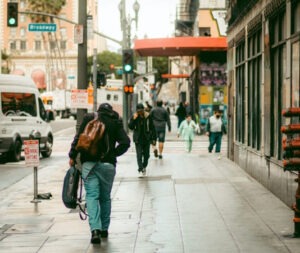
The Importance of California Pedestrian Laws
Everyone must know California Pedestrian laws. Not everyone can be a driver, but barring extraneous circumstances, everyone will most certainly be a pedestrian at some point in their lives.
In car-centric America, pedestrians everywhere are at risk of obtaining fatal and life-altering injuries (ie: Spinal Cord Injury, Traumatic Brain Injury) that could significantly change the trajectory of their lives —worse, maybe even stop them entirely.
While it may feel like cars are reigning supreme in these roads, pedestrians are also afforded rights and privileges to better protect themselves from harm. It is important to know them just in case you need to pursue legal action against reckless drivers.
Unfortunately, the legal protections that pedestrians have are not enough to curb the many pedestrian fatalities that they’re subjected to. Per National Public Radio, pedestrian accidents have worsened during the COVID-19 pandemic and after lockdown restrictions have eased.
As a matter of fact, 7,500 pedestrians were victims of wrongful death accidents in 2022, the highest it’s ever been since 1981. This means that one pedestrian on average is killed by a vehicle every 75 minutes nationwide according to the Centers for Disease Control and Prevention.
With worsening traffic and pedestrian fatalities, it’s clear that the need for a personal injury lawyer is more important than ever. That’s why it is important to know the rights of a pedestrian. Here are some of them
5 Important California Pedestrian Laws You Need To Know
1. Pedestrians must NOT walk along bike paths or lanes where designated sidewalks or pedestrian facilities are present.
However, if a pedestrian is found to have violated this law, they are protected from any persecutions from the police. But this doesn’t mean that they are relieved from their responsibility to exercise their “duty of care” to other people on the road.
Per the California Vehicle Code 21966, bikers and pedestrians alike must still ensure that they don’t harm each other. If it’s found that the pedestrian’s violation of CVC 21966 is the sole cause of the accident, then authority figures may use it against them.
2. Everyone must prioritize the safety of blind people walking on the road.
Any drivers who are not exercising their “duty of care” — aka ensuring the safety of all blind pedestrians — will be charged with a misdemeanor.
According to the California Vehicle Code 21963, they may be sentenced to 6 months in county jail and/or be charged with fines amounting to $1000 at most.
Clear indicators that someone is visually impaired on the road:
- They usually carry a white cane with a red tip while out in public.
- They may also have a guide dog walking alongside them.
Just remember this rule of thumb: blind pedestrians will always have the right-of-way. So if drivers encounter them during their drives, they need to remember to stay out of their way.
3. Unless they’re blind, no person should carry around a white cane
It is true that there are people who can see just fine yet bypass some people’s right of way by carrying a white cane with them. However, to err on the side of caution, you should automatically just assume that anyone who is carrying a white cane with them is blind.
But how will a driver know if the person carrying around a white cane is actually blind?
Well legally, only blind pedestrians are allowed to carry a white cane. Anyone with decent vision found to be carrying a predominantly white cane is in violation of California Vehicle Code 21964.
4. The legal definition of “blindness” per the California Vehicle Code
People casually use “blindness” to hyperbolically describe their “bad” vision as well as someone else’s. But “blindness” has a concrete legal term, one that is outlined in the California Vehicle Code 21965.
CVC 21965 makes a distinction between the three degrees of “blindness”
- “partially blind:” People who are “partially blind” suffer the least severe type of blindness of the three.
- “blind:” Significant decrease in visual perception but are able to attain some vision. They’re able to make out shapes to some extent but need something to aid their overall visual perception.
- “totally blind:” The most severe of the three, people who are “totally blind” may need to rely on their other senses to walk around and navigate the world.
5. Pedestrians are legally allowed to jaywalk in California.
As of January 1, 2023, California has legally allowed jaywalking to address the disproportionate rate at which people of color and other marginalized communities are being ticketed for crossing intersections.
This is through the provisions set by the Senate Bill 1107. It remains to be seen how this will affect pedestrian and traffic fatalities in the future.
The repercussions of the bill can also be seen in the insurance industry as insurance rates are predicted to go up in the coming years partly because of this bill.
THE TIGHTENING OF CALIFORNIA PEDESTRIAN LAWS
In the 1930s, the automobile was rapidly becoming an American staple, leading to the construction of highways and freeways.
Shortly after, the country’s economy skyrocketed. Market goods were being transported more efficiently, and certain cities grew to be the metropolises that they are today.
But this came with its own sets of repercussions. “Small town” America, as people knew it, faded into oblivion, and perhaps arguably more concerning was the rise of pedestrian fatalities.
Around this time, heavy metals were becoming a domineering force in the streets, leaving walking individuals (mostly children) vulnerable to personal injury or worse — death. As a result, jaywalking laws were enforced, barring people from crossing the streets to accommodate vehicles traveling to their destinations.
However, this was the first time laws of this nature were introduced. Prior to the pervasive presence of the automobile, crossing the streets was never regulated.
And while jaywalking laws have helped ease pedestrian-related fatalities overtime, they nevertheless put the onus of blame on the pedestrians rather than the drivers who are operating their vehicles recklessly. To make matters worse, the urban planning of many places in the nation (ie: California) prioritize vehicles over the safety of the people, indirectly creating the conditions that allow drivers to act as recklessly as they do.
Simply put, the main cause of the problem hasn’t been uprooted.
Indeed, jaywalking laws were passed with intent of protecting pedestrians, but the issues they do have still linger in the 21st century. This time, however, their effects have been found to disproportionately affect people across socioeconomic and racial backgrounds.
For this reason, California’s District 19 Assemblymember Phil Ting pushed to sponsor The Freedom To Walk Act.
THE EASING OF JAYWALKING LAWS IN CALIFORNIA
On October 1, 2022, Governor Gavin Newsom passed AB 2147 or The Freedom To Walk Act, which has legalized jaywalking in California effective January 1, 2023.
As aforementioned, this law is passed to address the inequities on how the police have enforced these laws, with certain racial groups found to be more disproportionately affected than others.
But fact of the matter is, urban planning in Los Angeles is not optimal for pedestrian safety. While this is a right step towards addressing the inequities born out of jaywalking laws, it remains to be seen how this will affect pedestrian safety.
For this reason, the Los Angeles Times reports that the University of California’s Institute of Transportation Studies will work together with the California Highway Patrol in putting together a report investigating how the decriminalization of jaywalking has affected pedestrian fatalities. This report is due on January 1, 2028.
SAFETY TIPS FOR PEDESTRIANS
-
Look both ways before crossing
-
Follow the timed crosswalk
-
Increase visibility by wearing bright clothing
SAFETY TIPS FOR CARS
-
Eyes on the road
-
Yield to all pedestrians
-
Don’t text and drive
Call Omega Law Group
But then again, pedestrian fatalities have worsened in spite of all the legal protections that pedestrians have. This is an issue that needs to be fixed systemically. Which is why you will need someone who knows the law like the back of their hand. If you or a loved one is involved in a pedestrian accident, you need to call a personal injury attorney.
You need to hire Omega Law Group.
The attorneys at Omega Law Group are highly-skilled. They tailor their legal services around the needs of their clients. This personalized approach to handling client matters has allowed them to accrue the respect of their colleagues in the industry. It landed them prominent features in Los Angeles Times and most notably, a headline story in the Los Angeles Business Journal.
With over millions of dollars acquired in settlement, the pedestrian accident experts at Omega Law Group is the firm you can hire.
While revered for their quality legal care, they stay true to their mission to provide equitable service to those who need it most, which is why they still operate on a contingency-fee basis. At Omega Law, they believe that quality and elite legal service should be accessible and affordable to all regardless of one’s financial standing.
We have represented clients who have been affected by various personal injuries, including Spinal Cord Injury, Traumatic Brain Injury, Soft Tissue Injury, and many more. Our awards and excellent testimonials are a result of our ability to empathize and attend to the needs of our clients. Here at Omega Law Group, you will come first.
If you or a loved one is suffering due to an accident, reach out to our team. Schedule a free consultation now to learn more!




